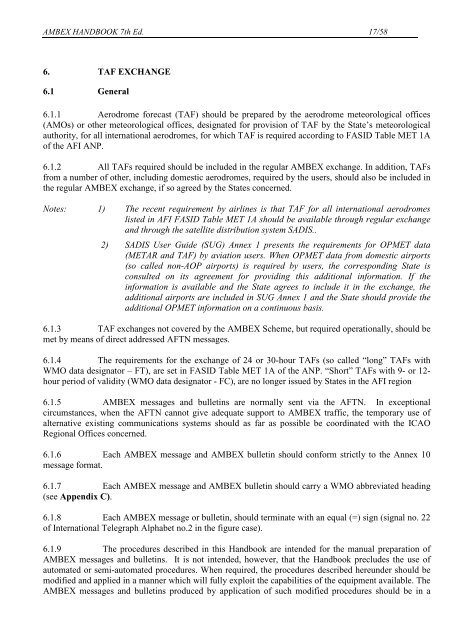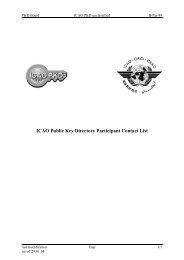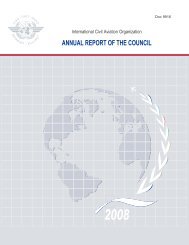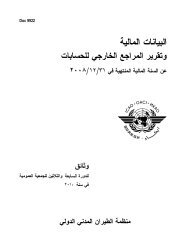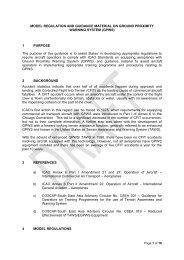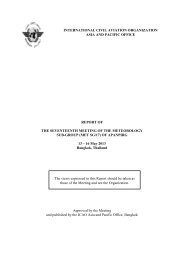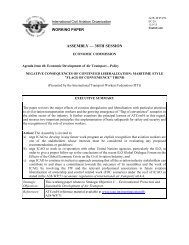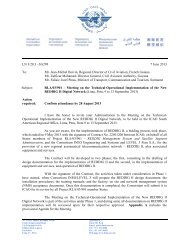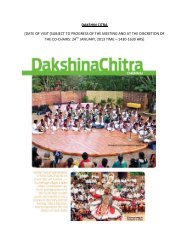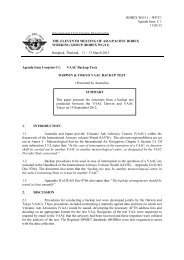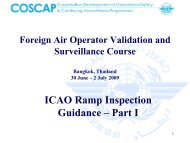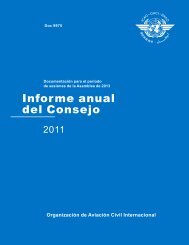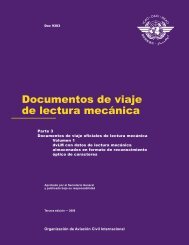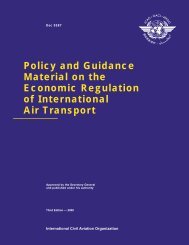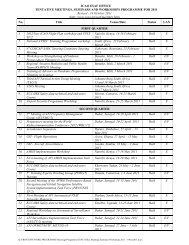afi met bulletins exchange (ambex) handbook - ICAO
afi met bulletins exchange (ambex) handbook - ICAO
afi met bulletins exchange (ambex) handbook - ICAO
You also want an ePaper? Increase the reach of your titles
YUMPU automatically turns print PDFs into web optimized ePapers that Google loves.
AMBEX HANDBOOK 7th Ed. 17/58<br />
6. TAF EXCHANGE<br />
6.1 General<br />
6.1.1 Aerodrome forecast (TAF) should be prepared by the aerodrome <strong>met</strong>eorological offices<br />
(AMOs) or other <strong>met</strong>eorological offices, designated for provision of TAF by the State’s <strong>met</strong>eorological<br />
authority, for all international aerodromes, for which TAF is required according to FASID Table MET 1A<br />
of the AFI ANP.<br />
6.1.2 All TAFs required should be included in the regular AMBEX <strong>exchange</strong>. In addition, TAFs<br />
from a number of other, including domestic aerodromes, required by the users, should also be included in<br />
the regular AMBEX <strong>exchange</strong>, if so agreed by the States concerned.<br />
Notes: 1) The recent requirement by airlines is that TAF for all international aerodromes<br />
listed in AFI FASID Table MET 1A should be available through regular <strong>exchange</strong><br />
and through the satellite distribution system SADIS..<br />
2) SADIS User Guide (SUG) Annex 1 presents the requirements for OPMET data<br />
(METAR and TAF) by aviation users. When OPMET data from domestic airports<br />
(so called non-AOP airports) is required by users, the corresponding State is<br />
consulted on its agreement for providing this additional information. If the<br />
information is available and the State agrees to include it in the <strong>exchange</strong>, the<br />
additional airports are included in SUG Annex 1 and the State should provide the<br />
additional OPMET information on a continuous basis.<br />
6.1.3 TAF <strong>exchange</strong>s not covered by the AMBEX Scheme, but required operationally, should be<br />
<strong>met</strong> by means of direct addressed AFTN messages.<br />
6.1.4 The requirements for the <strong>exchange</strong> of 24 or 30-hour TAFs (so called “long” TAFs with<br />
WMO data designator – FT), are set in FASID Table MET 1A of the ANP. “Short” TAFs with 9- or 12hour<br />
period of validity (WMO data designator - FC), are no longer issued by States in the AFI region<br />
6.1.5 AMBEX messages and <strong>bulletins</strong> are normally sent via the AFTN. In exceptional<br />
circumstances, when the AFTN cannot give adequate support to AMBEX traffic, the temporary use of<br />
alternative existing communications systems should as far as possible be coordinated with the <strong>ICAO</strong><br />
Regional Offices concerned.<br />
6.1.6 Each AMBEX message and AMBEX bulletin should conform strictly to the Annex 10<br />
message format.<br />
6.1.7 Each AMBEX message and AMBEX bulletin should carry a WMO abbreviated heading<br />
(see Appendix C).<br />
6.1.8 Each AMBEX message or bulletin, should terminate with an equal (=) sign (signal no. 22<br />
of International Telegraph Alphabet no.2 in the figure case).<br />
6.1.9 The procedures described in this Handbook are intended for the manual preparation of<br />
AMBEX messages and <strong>bulletins</strong>. It is not intended, however, that the Handbook precludes the use of<br />
automated or semi-automated procedures. When required, the procedures described hereunder should be<br />
modified and applied in a manner which will fully exploit the capabilities of the equipment available. The<br />
AMBEX messages and <strong>bulletins</strong> produced by application of such modified procedures should be in a


